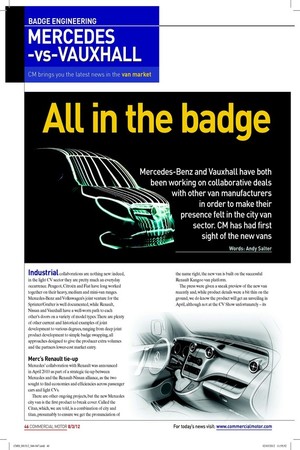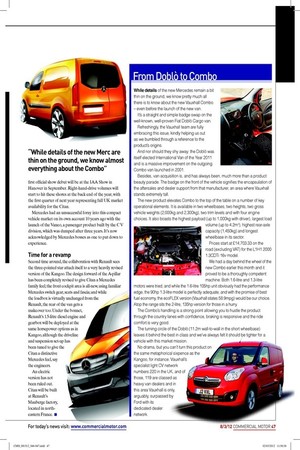All in the badge
Page 35

Page 36

If you've noticed an error in this article please click here to report it so we can fix it.
MERCEDES -vsVAUXHALL
CM brings you the latest news in the van market
Mercedes-Benz and Vauxhall have both been working on collaborative deals with other van manufacturers in order to make their presence felt in the city van sector. CM has had first sight of the new vans
Words: Andy Salter Industrial collaborations are nothing new: indeed, in the light CV sector they are pretty much an everyday occurrence. Peugeot, Citroën and Fiat have long worked together on their heavy, medium and mini-van ranges. Mercedes-Benz and Volkswagen’s joint venture for the Sprinter/Grafter is well documented, while Renault, Nissan and Vauxhall have a well-worn path to each other’s doors on a variety of model types. There are plenty of other current and historical examples of joint development to various degrees, ranging from deep joint product development to simple badge swapping, all approaches designed to give the producer extra volumes and the partners lower-cost market entry.
Merc’s Renault tie-up
Mercedes’ collaboration with Renault was announced in April 2010 as part of a strategic tie-up between Mercedes and the Renault-Nissan alliance, as the two sought to ind economies and eficiencies across passenger cars and light CVs.
There are other ongoing projects, but the new Mercedes city van is the irst product to break cover. Called the Citan, which, we are told, is a combination of city and titan, presumably to ensure we get the pronunciation of the name right, the new van is built on the successful Renault Kangoo van platform.
The press were given a sneak preview of the new van recently and, while product details were a bit thin on the ground, we do know the product will get an unveiling in April, although not at the CV Show unfortunately – its irst oficial show debut will be at the IAA Show in Hanover in September. Right-hand-drive volumes will start to hit these shores at the back end of the year, with the irst quarter of next year representing full UK market availability for the Citan.
Mercedes had an unsuccessful foray into this compact vehicle market on its own account 10 years ago with the launch of the Vaneo, a passenger product built by the C V division, which was dumped after three years. It’s now acknowledged by Mercedes bosses as one to put down to experience.
Time for a revamp
Second time around, the collaboration with Renault sees the three-pointed star attach itself to a very heavily revised version of the Kangoo. The design forward of the A-pillar has been completely revised to give Citan a Mercedes family feel; the front cockpit area is all-new, using familiar Mercedes switch gear, seats and fascia; and while the loadbox is virtually unchanged from the Renault, the rear of the van gets a makeover too. Under the bonnet, Renault’s 1.5-litre diesel engine and gearbox will be deployed at the same horsepower options as in Kangoo, although the driveline and suspension set-up has been tuned to give the Citan a distinctive Mercedes feel, say the engineers.
An electric version has not been ruled out.
Citan will be built at Renault’s Mauberge factory, located in north
eastern France. ■
AT A GLANCE From Doblò to Combo
While details of the new Mercedes remain a bit thin on the ground, we know pretty much all there is to know about the new Vauxhall Combo – even before the launch of the new van.
It’s a straight and simple badge swap on the well-known, well-proven Fiat Doblò Cargo van.
Refreshingly, the Vauxhall team are fully embracing this issue, kindly helping us out as we bumbled through a reference to the product’s origins.
And nor should they shy away: the Doblò was itself elected International Van of the Year 2011 and is a massive improvement on the outgoing Combo van launched in 2001.
Besides, van acquisition is, and has always been, much more than a product beauty parade. The badge on the front of the vehicle signifies the encapsulation of the aftersales and dealer support from that manufacturer, an area where Vauxhall stands extremely tall.
The new product elevates Combo to the top of the table on a number of key operational elements. It is available in two wheelbases, two heights, two gross vehicle weights (2,000kg and 2,300kg), two trim levels and with four engine choices. It also boasts the highest payload (up to 1,000kg with driver), largest load volume (up to 4.2m3), highest rear-axle capacity (1,450kg) and longest wheelbase in its sector.
Prices start at £14,703.33 on the road (excluding VAT) for the L1H1 2000 1.3CDTi 16v model.
We had a day behind the wheel of the new Combo earlier this month and it proved to be a thoroughly competent machine. Both 1.6-litre and 1.3-litre motors were tried, and while the 1.6-litre 105hp unit obviously had the performance edge, the 90hp 1.3-litre model is perfectly adequate, and with the promise of best fuel economy, the ecoFLEX version (Vauxhall states 58.9mpg) would be our choice. Atop the range sits the 2-litre, 135hp version for those in a hurry.
The Combo’s handling is a strong point allowing you to hustle the product through the country lanes with confidence, braking is responsive and the ride comfort is very good.
The turning circle of the Doblò (11.2m wall-to-wall in the short wheelbase) leaves it behind the best in class and we’ve always felt it should be tighter for a vehicle with this market mission.
No drama, but you can’t turn this product on the same metaphorical sixpence as the Kangoo, for instance. Vauxhall’s specialist light CV network numbers 220 in the UK, and of those, 119 are classed as heavy van dealers and in this area Vauxhall is only, arguably, surpassed by Ford with its dedicated dealer network.








































